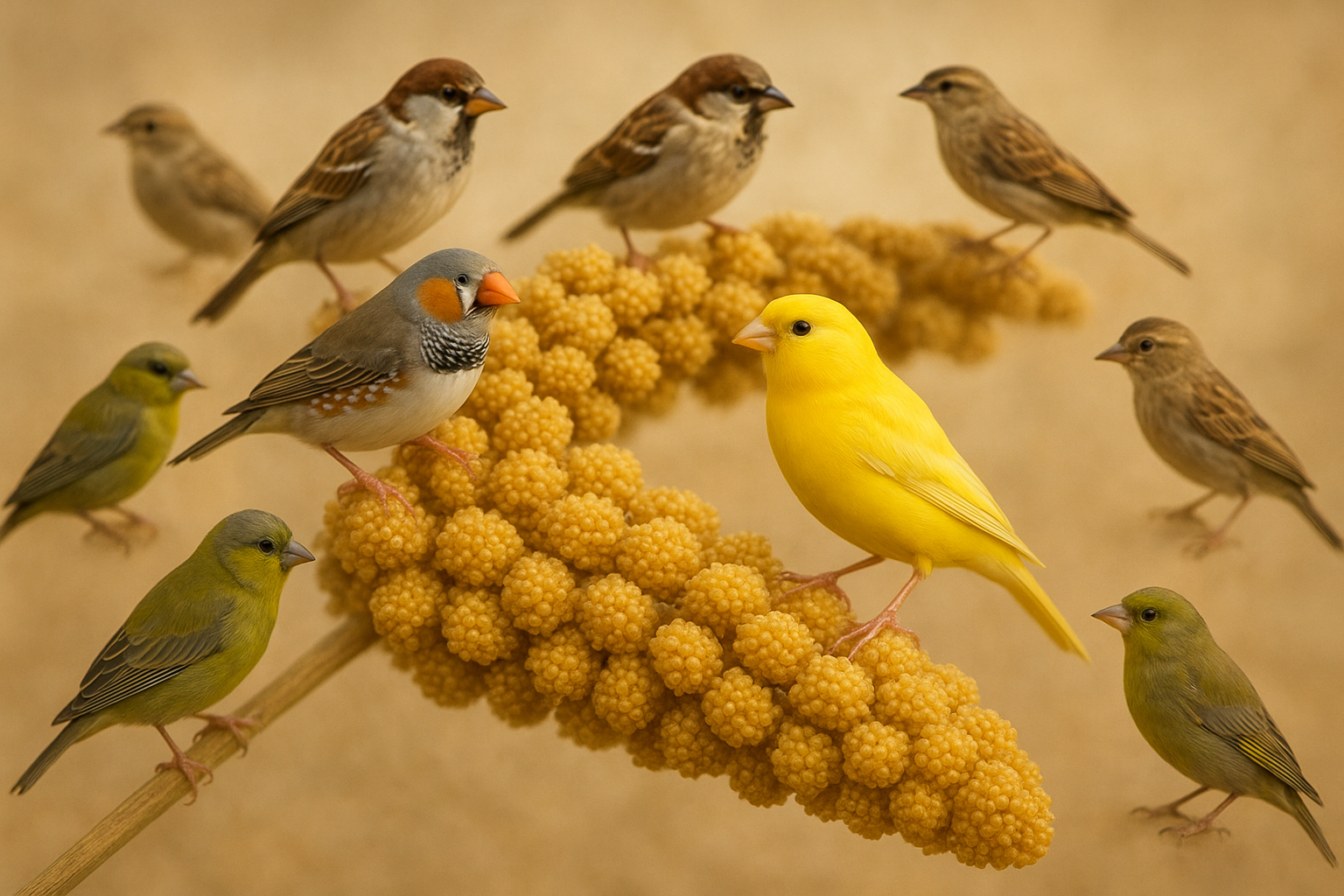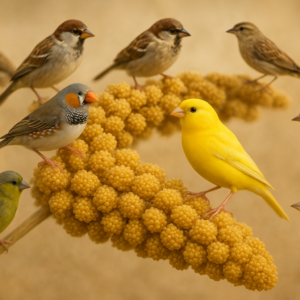Yellow millet has earned its reputation as one of the most popular bird seeds worldwide. Whether you’re feeding backyard wild birds or caring for pet parakeets and finches, this small golden grain offers real nutrition that keeps our feathered friends healthy and happy. If you’re looking for quality bird feed options, understanding the yellow millet benefits for birds can help you make better choices for your flock.
What Makes Yellow Millet Special for Birds?
Yellow millet belongs to the proso millet family, scientifically known as Panicum miliaceum. This annual grass produces small, round seeds that range from pale yellow to golden in color. Birds find it irresistible, and there’s good science behind their preference.
Yellow millet stands out for its high nutrient content, being particularly rich in essential amino acids and starch while remaining easy to digest. The seed’s smooth shell makes it easier for birds to crack open compared to red millet varieties, which is why so many bird species gravitate toward it.
Companies like CMS Industries recognize the importance of quality grains for animal feed. As an agricultural products manufacturer based in Gujarat, India, they supply various grains and animal feed products that meet nutrition standards for both livestock and bird feed markets.
Top 10 Benefits of Yellow Millet for Birds
1. High Nutritional Density Without Excessive Fat
Millet contains only 4% oil compared to 40% in sunflower and safflower seeds, making it a smart choice for maintaining healthy weight in birds. The seed is packed with magnesium, phosphorus, protein, and calcium, giving birds concentrated nutrition without the risk of obesity that comes from high-fat seeds.
For pet birds prone to weight gain, yellow millet offers a satisfying treat that won’t pack on extra pounds. Wild birds benefit too, especially during seasons when they need sustained energy without heavy fat loads.
2. Easy Digestibility for All Bird Species
One of the most significant yellow millet benefits for birds is how gentle it is on their digestive systems. Yellow millet provides amino acids and starch in forms that are very easy to digest. This makes it perfect for birds with sensitive stomachs or those recovering from illness.
The carbohydrate-rich composition gives birds quick energy that their bodies can process efficiently. Think of it as the bird equivalent of easily digestible whole grains in human diets.
3. Natural Stress Relief During Challenging Times
Millet is more digestive and calms birds, making it recommended for stressful periods such as molting, weaning, or reproduction. If you’ve ever noticed your birds seem more settled when eating millet, there’s a reason for that.
During molting, birds need extra calories and nutrients while their bodies work overtime to produce new feathers. Yellow millet provides this nutritional boost in a form that doesn’t tax their systems. The same goes for breeding season, when parent birds need sustained energy for raising chicks.
4. Perfect for Weaning Baby Birds
Millet is great for baby birds when they are weaning because it offers them a lot of calories to finish developing. The small seed size is perfect for tiny beaks just learning to crack and eat solid food.
Parent birds often feed millet to their chicks, and young birds naturally gravitate toward it during the weaning process. The protein content supports rapid growth and feather development, while the easily digestible starches provide energy for learning to fly and explore.
5. Encourages Natural Foraging Behavior
When offered as spray millet (the seeds still attached to the stalk), yellow millet gives birds the chance to forage naturally. It has an appealing texture and delicate taste, and satisfies a bird’s need to forage by harvesting his own seed.
This natural behavior keeps birds mentally engaged and prevents boredom. For caged birds especially, spray millet provides entertainment and exercise as they work to strip the seeds from the stem. It’s both nutrition and enrichment in one package.
6. Supports Recovery in Sick or Reluctant Eaters
Millet is often offered freely when a bird is ill and doesn’t want to eat its regular diet, as it’s better for a sick bird to eat something rather than nothing at all. The palatability of yellow millet often tempts sick birds to eat when they’ve lost interest in other foods.
For birds recovering from illness or injury, the easily digestible nature of yellow millet means their bodies can access nutrients without working too hard. Veterinarians and bird specialists often recommend it as a recovery food for this reason.
7. Rich in Essential Minerals and Vitamins
White proso millet seed is high in vitamins, especially vitamins B1, B2, B6 and K, and high in minerals, especially phosphorus, copper, zinc, iron, potassium, calcium, magnesium and manganese. This mineral profile supports everything from bone health to feather quality.
The B-complex vitamins play roles in metabolism, helping birds convert food into usable energy. Calcium and phosphorus work together for strong bones, while minerals like zinc and copper support immune function. CMS Industries, as a supplier of various agricultural products and animal feed, understands the importance of these nutritional components in quality bird seed mixes.
8. Helps Transition Seed-Addicted Birds to Varied Diets
Since birds relish millet, you can use it to help wean your bird off its seed and nut addiction, and introduce a more varied diet. Many pet bird owners struggle with birds that refuse anything but sunflower seeds or peanuts. Yellow millet can be the bridge food that helps transition these picky eaters.
Because birds find it so tasty, you can gradually mix yellow millet with other healthy foods, slowly shifting their diet toward better variety. This strategy works because you’re not taking away something they love; you’re adding it to foods they need to learn to eat.
9. Appeals to a Wide Variety of Bird Species
According to a study conducted by the Laboratory of Ornithology, millet is the preferred food of many birds that feed on the ground, including quail, sparrows, pigeons, and cardinals. But ground feeders aren’t the only fans.
Finches, canaries, parakeets, budgies, cockatiels, doves, and many other species eagerly consume yellow millet. This broad appeal makes it a smart choice for mixed-species aviaries or backyard feeders where you want to attract diverse birds. If you’re buying seed from agricultural suppliers like CMS Industries, yellow millet in your mix will satisfy the widest range of visiting birds.
10. Cost-Effective Nutrition
Yellow millet offers exceptional nutritional value relative to its cost. It’s generally less expensive than specialty seeds while providing solid nutrition. For people maintaining backyard feeding stations or caring for multiple birds, the economics matter.
The seed stores well when kept dry, meaning you can buy in bulk without worrying about rapid spoilage. This combination of affordability, nutrition, and storage stability makes yellow millet a practical choice for bird enthusiasts on any budget.
Want to understand what is yellow millet and its amazing health benefits? — please read this blog!
How to Feed Yellow Millet to Birds
Portion Control Matters
While yellow millet benefits for birds are numerous, moderation remains important. A teaspoon of seed per day is a good-size snack for a budgie. The seed should complement a varied diet rather than replace it entirely.
For spray millet, cut it into smaller pieces rather than offering whole stalks. This helps control portions and prevents birds from filling up exclusively on millet while ignoring other nutritious foods.
Mixing with Other Seeds
Yellow millet works best as part of a balanced seed mixture. Combine it with other grains, seeds, and nutritious foods to create a complete diet. It is still recommended to mix it with other seeds so that they have a varied diet.
Consider blending yellow millet with striped sunflower seeds, safflower, or other grains. Agricultural suppliers like CMS Industries typically offer various seed options that can be mixed to create balanced feed formulations.
Different Feeding Methods
You can offer yellow millet in several ways:
- Seed feeders: Tube or hopper feeders work well for dispensing loose millet to perching birds
- Ground feeding: Scatter millet on clean ground or platform feeders for species like sparrows and doves that prefer feeding at lower levels
- Spray millet: Clip whole stalks to cage bars or hang them from hooks, giving birds a foraging challenge
- Mixed into recipes: Some bird owners bake millet into bird-safe treats or add it to seed blocks
Choose the method based on the bird species you’re feeding and their natural feeding preferences.
Understanding Yellow Millet vs Other Millet Varieties
Yellow millet is one of several millet types available for birds. White proso millet is the most common in commercial seed mixes. White millet is rich in carbohydrates, potassium, iron, magnesium, sodium and vitamin A and B complex.
Red millet has its place too. Red millet has a higher proportion of fat and is ideal for providing protein to the diet, but should always be accompanied by white and yellow varieties. The higher protein content makes red millet useful for breeding birds or growing chicks, but the increased fat means it needs to be balanced with lower-fat varieties like yellow millet.
Many birds show color preferences. Some finches prefer red millet’s smaller seeds, while sparrows and juncos often choose white or yellow varieties. If your birds aren’t eating one type, try another to find their preference.
Common Questions About Yellow Millet Quality
When sourcing yellow millet, quality matters. Look for:
- Clean seeds without excessive debris or chaff
- Dry, properly stored millet that hasn’t been exposed to moisture
- Seeds with bright, consistent color rather than dull or faded appearance
- Fresh product rather than old stock that’s been sitting in storage
Reputable agricultural suppliers maintain quality standards for their animal feed products. CMS Industries, for example, emphasizes quality across their range of grains and agricultural products exported globally from their Gujarat facilities.
Potential Limitations to Consider
While the yellow millet benefits for birds are substantial, it’s worth noting some limitations. Millet has absolutely no vitamin A, an essential vitamin for birds. This reinforces why millet should be part of a varied diet rather than the sole food source.
Birds fed only millet would eventually develop nutritional deficiencies. Balance it with fresh vegetables, quality pellets, and other seeds that provide the full spectrum of nutrients birds need for long-term health.
Storage Tips for Maximum Freshness
Store yellow millet in airtight containers in cool, dry locations. Moisture is the enemy of seed quality, potentially leading to mold growth that can harm birds. Check stored seed regularly for signs of spoilage, unusual odors, or insect infestation.
Buy quantities you’ll use within a few months rather than stocking up for years. Even properly stored seed gradually loses nutritional value over time. Fresh seed means maximum nutrition for your birds.
Conclusion
The yellow millet benefits for birds make it a staple in both wild bird feeding and pet bird care. From its easily digestible nutrients to its stress-reducing properties, this golden seed supports avian health in numerous ways. Whether you’re sourcing quality grains from agricultural suppliers like CMS Industries or buying small bags for backyard feeders, yellow millet deserves a place in your bird feeding routine.
Remember that while yellow millet is excellent nutrition, variety remains the key to optimal bird health. Combine it with other quality seeds, fresh foods, and species-appropriate diets to give your feathered friends everything they need to thrive. Your birds will thank you with their vibrant feathers, cheerful songs, and energetic behavior.
FAQs About Yellow Millet Benefits for Birds
Q1: Can I feed yellow millet to wild birds year-round?
Yes, yellow millet works well for wild bird feeding in all seasons. Birds particularly appreciate it during winter when they need extra calories for warmth and in spring during breeding season when they require additional nutrition for raising chicks. Just make sure feeders stay clean and dry to prevent mold growth during wet weather.
Q2: Will yellow millet attract unwanted birds to my feeder?
Yellow millet primarily attracts seed-eating birds like finches, sparrows, and doves. It’s less likely to draw larger, more aggressive species compared to corn or peanuts. If you’re concerned about specific birds, adjust your feeder style rather than eliminating millet from your mix.
Q3: How much yellow millet should I include in homemade bird seed mixes?
A good starting ratio is 20-30% yellow millet combined with 50-60% sunflower seeds (black oil or striped) and 10-20% other seeds like safflower or nyjer. This creates a balanced mix that appeals to many bird species while providing varied nutrition.
Q4: Is yellow millet safe for all pet bird species?
Yellow millet is safe for virtually all seed-eating pet birds, including parakeets, finches, canaries, cockatiels, and small parrots. Larger parrots can eat it too, though it may be small for their beaks. Always introduce new foods gradually and watch for any unusual reactions.
Q5: Can birds eat too much yellow millet?
Birds can overeat millet if it’s the only food available or offered in unlimited quantities. This can lead to nutritional imbalances since millet lacks certain vitamins like vitamin A. Offer it as part of a balanced diet, controlling portions to ensure birds eat varied foods throughout the day.





